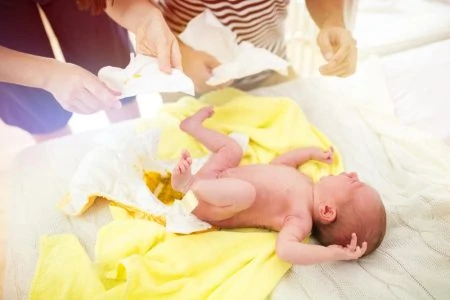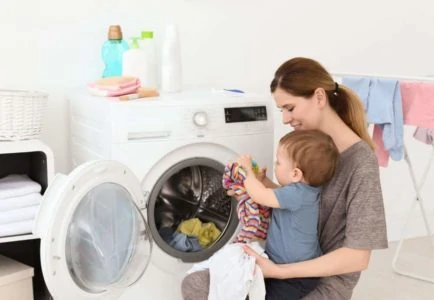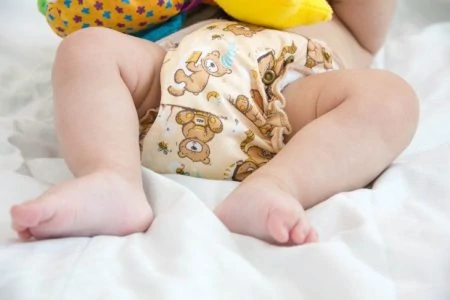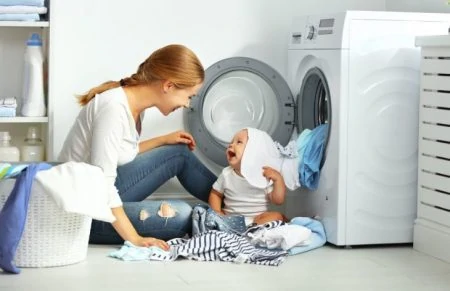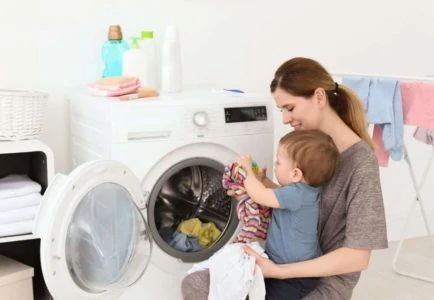Has your baby ever had such a massive blowout that poop was all the way up their back, turning a simple diaper change into a full wash-down in the bathtub?
We’ve had this happen more times than we can count!
As a result, we’ve spent hours researching, listening to the advice of other moms, and trying every possible cleaning hack to create this guide for saving your clothes and your sanity.
It is possible to remove stubborn poop stains and get your cloth diapers, baby clothes, and even your carpet (yes, this happens) looking as good as new.
We’ll show you the most effective methods and the safest products for removing those pesky poop stains.
Key Takeaways
- To remove stubborn poop stains from cloth diapers, baby clothes, or carpets, the first step is to remove or rinse off as much poop as possible.
- Soak the stained item in warm water, use a stain remover such as Buncha Farmers Stain Stick, Lemon Juice, OxiClean White Revive, or a homemade solution of Dawn dish soap, hydrogen peroxide and baking soda.
- Scrub the stained area with a cleaning brush or toothbrush, let it sit for 10-15 minutes, then machine or hand wash as usual.
- Sun-drying the item can also help remove stains.
- To prevent stains, consider using cloth diapers or fleece liners inside disposable diapers. Poop can easily be rinsed out of fleece liners, and they can be washed and reused.
How To Prevent Poop Stains
Cloth diapers are great at preventing blowouts because of their shape and elastic gussets around the waist and legs. Even if you prefer the convenience of disposable diapers, it’s worth it to invest in a handful of cloth diaper covers to protect the disposables.
With cloth diapers, you won’t have to change your baby’s outfit every time they poop or hose them down in the bathtub after every messy diaper change.
If you already use cloth diapers, cut up fleece liners and lay them inside your diapers to catch the poop and prevent stains. Poop rinses out of fleece liners easily, especially once your baby is on solid food.
Many stores sell fleece blankets for next to nothing, and you can cut out around 30 liners from one throw blanket.
Some moms use Viva paper towels as diaper liners, although they may not be as environmentally friendly. Fleece liners are a more cost-effective option as they can be washed and reused if necessary.
Removing Stubborn Poop Stains
Sunning alone works wonders as a natural bleacher for most stains (1). However, this isn’t always an option if you live somewhere with dreadfully cold winters or in an apartment without space to hang clothes outside. Plus, there are always those stubborn poop stains in need of a little something extra. Here is what we recommend.
1. Remove The Poop
Rinse off poop from cloth diapers and garments as soon as possible. A cloth diaper sprayer is a terrific device you can hook right up to your toilet to save your sanity! If you’re dealing with poop on your carpet, try to pick up as much as possible (using a plastic bag or rubber gloves) so you don’t mash anything into the floor.
2. Soak In Water
Soak the poop-stained garment in warm water. For cloth diapers, carpets, or other fabrics, use a spray bottle to soak the stained area.
3. Use One of These Stain Removers
Pick one of these stain removers, depending on whether you favor natural or synthetic products.
Natural Stain Removers
- Buncha Farmers Stain Stick: Rub the stain stick directly on the dampened stain, or fill a spray bottle with hot water and finely grate some of the stick into the bottle. Mix before spraying. Wash diaper as usual.
- Lemon Juice: Either squirt a tiny bit directly on the wet stain or combine 1/4 cup lemon juice with 1 cup water in a spray bottle. Spray the stained area. Wash diaper as usual.
Synthetic Stain Removers
- OxiClean White Revive: Pour a small amount directly onto the stain before washing.
- Shout Stain Remover: Spray on the stain prior to washing.
Homemade Stain Removers
- Dawn dish soap, hydrogen peroxide, and baking soda: Dawn isn’t an all-natural product, but this trio is effective. Combine two parts peroxide with one part Dawn and one part baking soda. To make a large batch that can be used for future stains, combine two cups peroxide and one cup each of Dawn and baking soda.
4. Scrub And Let Sit
After applying a stain remover, scrub the stained area using a toothbrush or small scrub brush. Let it sit for at least 10–15 minutes after scrubbing.
5. Wash Thoroughly
Wash the garments or diapers as you normally would, or throw cloth diapers in the diaper pail until the next wash. Be sure to use a baby-safe laundry detergent or cloth-safe detergent (if you’re using cloth diapers).
For carpets, rinse using a spray bottle filled with cool water. Then pat dry with a cloth or towel or place a fan over it.
6. Dry In The Sun
If possible, hang the garments and diapers in the sun to dry after washing. Remember to hang colored or printed clothes inside out to prevent fading. Hang cloth diapers “hot dog style” to avoid stretching out the elastics.
Safe Cleaning Products For Cloth Diapers
If you are trying to remove stains from cloth diapers, make sure to use a cloth diaper laundry detergent and stain remover. There are online detergent indexes to check the safety level of your cleaning agents. All the stain removers listed in this article have been approved as safe for cleaning cloth diapers (2).
